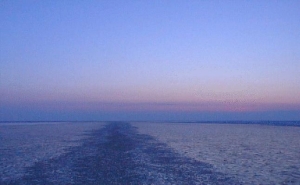The ice season 2003/2004 was average
When classified by the extent of the ice cover, the ice season 2003/2004 was average.
In the northern Bay of Bothnia the freezing started towards the end of November and on the coast of the Sea of Bothnia after mid-December, that is approximately a week later than average. In the eastern part of the Gulf of Finland, in the Bay of Vyborg and off St. Petersburg the freezing started in mid-December, that is approximately two weeks later than usual, and in the Archipelago Sea and in the western and middle parts of the Gulf of Finland at the turn of the year, that is at the average time.
During December the amount of ice increased slowly in the northern Bay of Bothnia so that at the turn of the year there was ice from north to west of Hailuoto. In the southern Bay of Bothnia, Sea of Bothnia and the Gulf of Finland there was thin fast ice and new ice in the archipelago.
In the beginning of January the weather was cold and new ice was formed along the coast in both the Gulf of Bothnia and Gulf of Finland. In mid-January an ice cover was formed in the Quark and in the eastern part of the Gulf of Finland there was ice to Motshnyj. The Bay of Bothnia was totally covered by ice on the 23rd of January that is approximately a week later than average. The end of January was mild and windy. Ridges were formed in the ice field in the northern Bay of Bothnia and the ice was rafted in both the Bay of Bothnia and Gulf of Finland. At the same time a brash ice was formed at the ice edge.
In the first part of February there were short periods of cold weather during which the ice thickened and ice was formed in the Sea of Bothnia and the Gulf of Finland. In the mid-February there was ice to the line Storkallegrund–Agö in the northern Sea of Bothnia and along the Finnish coast there was a 10–20 nautical miles wide belt of thin ice. In the Gulf of Finland there was ice from the east to the longitude of Hanko. The end of February was mild and the ice started receding so the ice edge in the northern Sea of Bothnia shifted to the Quark and in the Gulf of Finland to the line Porkkala–Kalbådagrund–Narva. At the same time ridges were formed in the ice field.
In the beginning of March a period of cold weather set in and more new ice was formed rapidly. The largest ice cover – 153 000 km² – was reached on the 11th of March. The Bay of Bothnia, Archipelago Sea and the Gulf of Finland were then totally covered by ice. In the open sea of the Sea of Bothnia there was open water, but off the Finnish coast there was 15–20 nautical miles ice and off the Swedish coast 30–45 nautical miles ice. In the northern Baltic Sea the ice edge ran along the line Utö–Osmussaar. In the mid-March the weather got milder and the ice receded rapidly.
In the beginning of April the open sea of the Sea of Bothnia was open and there was ice only in the archipelago. In the Gulf of Finland there was a wide lead from the inlet of Vyborg Bay to Kalbådagrund and from there to the west the sea was open except for the archipelago.
In all sea areas the ice broke up at the average time: in the Archipelago Sea, the Sea of Bothnia and the western Gulf of Finland after mid-April, in the eastern Gulf of Finland in the end of April, in the southern Bay of Bothnia in the first part of May and in the northern Bay of Bothnia in the end of May.
The maximum thickness of fast ice in the northern Bay of Bothnia was 50 to 75 cm, in the Sea of Bothnia 40 to 50 cm, in the Archipelago Sea 20 to 40 cm, in the western Gulf of Finland 35 to 45 cm and in the eastern Gulf of Finland, 40 to 65 cm. The ice thickness in open sea was 40 to 60 cm in the Bay of Bothnia, 10 to 20 cm in the Sea of Bothnia, 10 to 25 cm in the western Gulf of Finland and 25 to 50 cm in the eastern Gulf of Finland.
The duration of the ice season was average in the Archipelago Sea and the western and middle parts of the Gulf of Finland. In the Bay of Bothnia and the Sea of Bothnia the ice season was approximately a week, and in the eastern Gulf of Finland approximately two weeks, shorter than average.
Simo Kalliosaari

